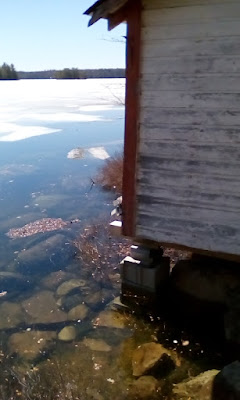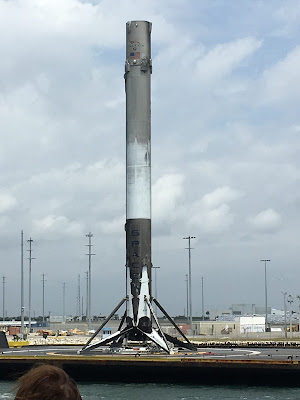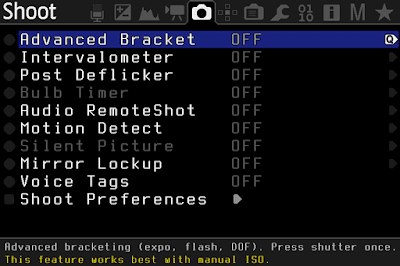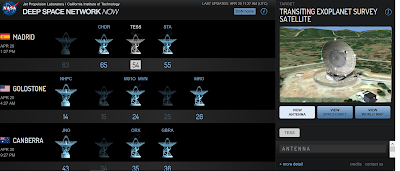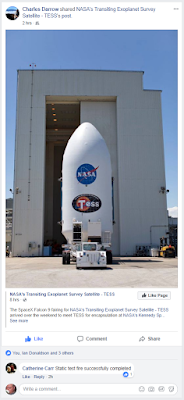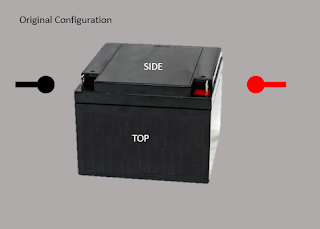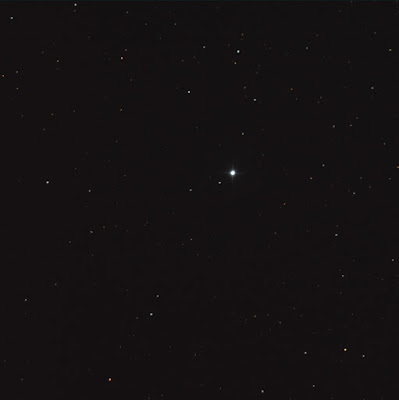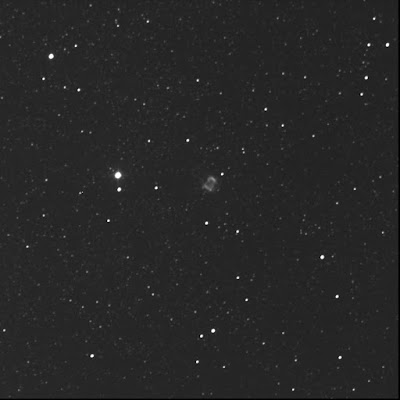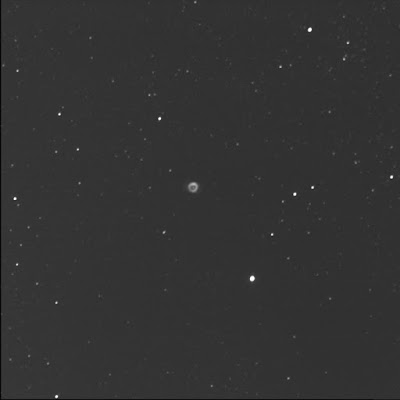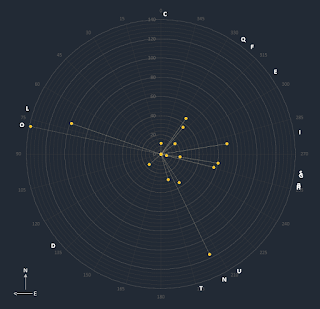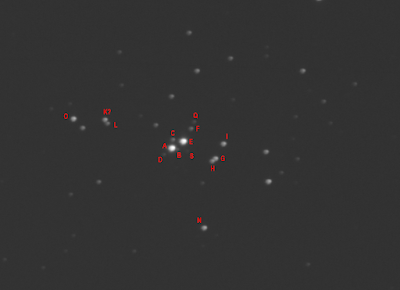Sunday, April 29, 2018
NEOS online
Learned that New Eyes Old Skies closed the store, the brick-and-mortar store. They are still operating but online only.
Labels:
equipment
checked camera
Checked the pinhole camera overlooking Kosklong Lake. Looks OK. We plan to tear it down during the Strawberry Social. The camp peeps are keen to see the result.
Might need hip waders to reach it...
Might need hip waders to reach it...
Labels:
friends and family,
photography
Saturday, April 28, 2018
still lots of snow
Heard some of the roads about the Carr Astronomical Observatory have a metre of snow. Wow.
Friday, April 27, 2018
found north (Koshlong Lake)
Saw a hazy Moon walking to the Long House. Afterwards, while heading back to our cabin, I picked off some constellations. And then got my bearing. Wasn't sure though what the bright point in the south was...
Labels:
constellations,
Moon,
naked,
stars
Wednesday, April 25, 2018
new power tanks
Learned of the new Celestron powertanks using lithium technology. These might better than their old "classic" style of powertank. LiFePO4 offers a number of advantages such as being much lighter, can be recharged 2000 times, and have a slower self-discharge rate. What I found most interesting is that there was not a huge white search light on the front...
watched meeting
Watched the RASC Toronto Centre meeting, streamed it online. Enjoyed Phil's talk on planned upgrades to the CAO. Was fascinated by Tom's talk on thin, meniscus mirrors for fast telescopes.
Was pleased when my question in the chat was forwarded to Tom.
The raw video is available for viewing.
Was pleased when my question in the chat was forwarded to Tom.
The raw video is available for viewing.
Labels:
RASC
Tuesday, April 24, 2018
learned of new camera
Noticed a pinned tweet from the Burke-Gaffney Observatory. A new camera, a SBIG, has been been added to the OTA. Actually, I think it was physically installed some time ago but only now implemented. Notably, the narrow band filters have been moved to the new camera. A sulphur filter was added. There are a couple of new science filters as well. Another interesting feature of the new setup is that it can take much shorter exposures. So I've got some learnin' to do...
Labels:
equipment,
photography
Monday, April 23, 2018
saw a Moon rising (Coldwater)
Spotted the gibbous Moon rising between buildings on the east side of main drag. Meh.
did I see a logo?
Out of the corner of my eye, as the older woman with black vest walked across the street, 'round the front of her truck, and climbed in the passenger side, I thought I spotted the RASC crest! But I didn't recognise her. Nor the male driver. Huh. Funny seeing this in the middle of nowhere, downtown Coldwater, as I waited for rho in the coffee shop. Then again. The late Mr Gaherty might have encouraged some of the locals to join...
Labels:
RASC
Sunday, April 22, 2018
returned to NGC 4216 (Halifax)
Charged BGO with shooting 4216 again. A satellite ran through it 20 May '17. I wanted to revisit again to get more data.
Luminance only, 60 seconds subexposures, 10 stacked shots. FITS Liberator, GIMP. North is up; east is left.
A good result, i.e. no tumbler; but the contrast and detail seems better in the first. The Moon was up...
§
I noticed that the field is rotated slightly, about a degree or two, from the old photo...
Luminance only, 60 seconds subexposures, 10 stacked shots. FITS Liberator, GIMP. North is up; east is left.
A good result, i.e. no tumbler; but the contrast and detail seems better in the first. The Moon was up...
§
I noticed that the field is rotated slightly, about a degree or two, from the old photo...
Labels:
Apogee,
galaxies,
NGC,
photography
returned to NGC 4039 (Halifax)
I sent the BGO robot back to NGC 4039 and 4038, The Antennae galaxies, to hopefully improve from previous attempts.
Luminance only, 60 seconds subexposures, 10 stacked shots. FITS Liberator, GIMP. North is up; east is left.
I think this is the best result to date... Or very similar to the first (which included a satellite). A challenging target to be sure. Not sure if there's anything I can do to draw out the antennae proper...
Imaged on 22 Dec '17, 27 Jan '18, and 27 Feb '18.
Luminance only, 60 seconds subexposures, 10 stacked shots. FITS Liberator, GIMP. North is up; east is left.
I think this is the best result to date... Or very similar to the first (which included a satellite). A challenging target to be sure. Not sure if there's anything I can do to draw out the antennae proper...
Imaged on 22 Dec '17, 27 Jan '18, and 27 Feb '18.
Labels:
Apogee,
galaxies,
NGC,
photography
shot 27 Hya (Halifax)
The good weather we deserved in Ontario rolled into Nova Scotia. The Burke-Gaffney Observatory started off for me on a multi-star system, 27 Hydrae, by centring on GSC 05463 00209. I was hoping to split the B and C elements.
Luminance only, 1 second subexposures, 20 stacked shots. FITS Liberator, GIMP. North is up; east is left.
I was not able to split B and C from the backyard on 19 Mar '18. No problem in the image! South-south-west of B. It is clearly very faint compared to the second star. Similar in brightness to nearby magnitude 12 stars.
§
Wikipedia link: 27 Hydrae.
Luminance only, 1 second subexposures, 20 stacked shots. FITS Liberator, GIMP. North is up; east is left.
I was not able to split B and C from the backyard on 19 Mar '18. No problem in the image! South-south-west of B. It is clearly very faint compared to the second star. Similar in brightness to nearby magnitude 12 stars.
§
Wikipedia link: 27 Hydrae.
Labels:
Apogee,
double stars,
photography
repaired second cross-hair
Glued cross-hair two. I'll have to be gentle in the future...
Labels:
Celestron,
equipment,
photography,
repair
watched the video
Watched Tony's video, on Facebook, of the TESS launch. Very nice. Noted the time delay for the sound. Took about 30 seconds.
Labels:
exoplanets,
friends and family,
NASA,
science
Saturday, April 21, 2018
back at base
Here's the beauty that launched the Transiting Exoplanet Survey Satellite into space.
Looks like it hit the centre of the bull's eye.
Looks like it hit the centre of the bull's eye.
beyond human vision
Stumbled across the Micro Macro web page developed by the NASA Chandra X-ray Center. They compare a few things at the nanometre then kilometre or light-year scales. Neat.
sent a note
Finally sent a thank-you note to RASC Toronto Centre awards committee for the OVSA award.
[Edited for the correct committee name.]
[Edited for the correct committee name.]
Labels:
RASC,
volunteering
he found it very useful
Out of the blue, received an email from Tenho of Saskatoon, which he also shared with the editor. He said he "found something so useful [that] I thought I should write about it." On reading my Binary Universe article in the October 2017 Journal entitled Hacking your Canon P&S, Tenho followed up the mention of the Magic Lantern software for Canon EOS cameras. He hacked his Rebel T5i/700D primarily so to have an on-board intervalometer. This means he can now operate his camera without an external accessory.
Nice! It's good to hear from readers. But it especially interesting this note as the reference to ML was incidental.
§
Suggested he look for the red light mode setting!
Nice! It's good to hear from readers. But it especially interesting this note as the reference to ML was incidental.
§
Suggested he look for the red light mode setting!
Labels:
hack,
photography,
RASC
started cross-hair repair
Redo. Removed the old cross-hairs from the Celestron 6x30 finder scope. Added a new one—thank you Rhonda. Glued with Home-Bond Solvent Contact Cement. I had broken one of the cross-hairs during the barn door tracker upgrades last weekend.
Labels:
DIY,
equipment,
photography,
repair
happy IAD!
Happy International Astronomy Day! Keep looking up. Keep wondering. Keep asking why, how far, when, how...
Friday, April 20, 2018
saw TESS on DSN
Charles shared a screen snapshot on Facebook. Very cool to see TESS listed on the Deep Space Network.
Visit DSN Now (at the right time) to see the probe communicating with the Earth...
[Edited to add link.]
Visit DSN Now (at the right time) to see the probe communicating with the Earth...
[Edited to add link.]
Labels:
exoplanets,
friends and family,
NASA,
science
Wednesday, April 18, 2018
learned TESS is powered
Missed the launch; I was shovelling the driveway! Sheesh. Received Tony's email from Florida as they were heading to the viewing site. Finally checked Spaceflight Now and Facebook. Learned SpaceX successfully launched. Yeh! Reloaded Spaceflight and learned that, as of 19:58, Transiting Exoplanet Survey Satellite was "power positive." The feed history reported:
§
Lots of good info in the SpaceflightNow.com article.
The TESS spacecraft is receiving power generated by its twin solar arrays and ground controllers are [pouring] over telemetry as they check out of the spacecraft's systems following launch.Great, great news.
§
Lots of good info in the SpaceflightNow.com article.
Labels:
friends and family,
NASA,
science,
SpaceX
Tuesday, April 17, 2018
OK to go
Spotted Charles's note on Facebook regarding TESS. He says they are good to go for tomorrow.
Labels:
friends and family,
NASA,
science,
SpaceX
Monday, April 16, 2018
read tracker comparison
Found a good comparison of tracking mounts. It compares camera mounts I've heard of like the Star Adventurer and the Polarie with ones I've not heard such as NanoTracker and Minitrack-LX.
The article by Lorenzo Comolli, while dated, contains mini-reviews of the units with a large table showing features and capabilities.
The article by Lorenzo Comolli, while dated, contains mini-reviews of the units with a large table showing features and capabilities.
Labels:
equipment
learned about SkyGuider
Chatted with Wayne today via Facebook. He has ordered the iOptron SkyGuider Pro. Never heard of it. It is a new astronomy tracking mount for cameras. This summer, it'll be neat to see it in action. Told Wayne about my BDT progress. This whole arena is getting very interesting...
Labels:
equipment,
friends and family,
photography
explosions and green fuzzies
Nick recently put out a query on the RASC TC forum. He wanted to know good sources for supernovae and comets.
He indicated he preferred a simple website. He said he found "some resource websites are not very intuitive or user-friendly."
Bryon suggested aerith.net for comets, specifically the Weekly Information page.
Eric said "the best site for... supernovae is not far away, just over Lake Ontario in Rochester, NY." I wondered what Nick might think of this as I find Latest Supernovae page challenging to decipher.
There was no mention of Comet Chasing page at Skyhound...
I reminded Nick that his SkyTools Starter Edition software should help.
He thanked us.
He indicated he preferred a simple website. He said he found "some resource websites are not very intuitive or user-friendly."
Bryon suggested aerith.net for comets, specifically the Weekly Information page.
Eric said "the best site for... supernovae is not far away, just over Lake Ontario in Rochester, NY." I wondered what Nick might think of this as I find Latest Supernovae page challenging to decipher.
There was no mention of Comet Chasing page at Skyhound...
I reminded Nick that his SkyTools Starter Edition software should help.
He thanked us.
Labels:
comets,
planning,
RASC,
software,
supernova remnants
TESS scrubbed
Learned the TESS launch was scrubbed for today! Grace (on Facebook) and Tanya (on Twitter). No reason why yet... I think I read somewhere that there are no good windows until later in the week.
§
From SpaceX's Twitter feed:
§
From SpaceX's Twitter feed:
Standing down today to conduct additional [Guidance, Navigation, and Control] analysis, and teams are now working towards a targeted launch of @NASA_TESS on Wednesday, April 18.The next launch opportunity will come at 6:51 PM EDT Wednesday. The launch times change based on TESS's orbital target and the position of the moon, which the satellite will use to help maneuver into its final high-altitude science orbit.
Labels:
friends and family,
NASA,
science,
SpaceX
they made it
I was glad to see the Toronto contingent made it out of the ice storm for Florida for the TESS launch.
Launching from Complex 40...
Launching from Complex 40...
Labels:
friends and family,
weather
Sunday, April 15, 2018
learned how to align
I actually found this Cloudy Nights thread on a barn door tracker a long time ago but only now just read it thoroughly... The original poster "corduroy" followed Seronik's BDT design but had some questions, one of which was on aligning the polar scope. User "evan9162" replied. Wow. The procedure described, using Live View on the camera, is amazing, simple, easy to do. It ensures co-axial alignment of the 'scope and the hinge. And, curiously, allows the finder scope to be anywhere on the tracker! I could move it back to the bottom plate if I want...
Labels:
Celestron,
equipment,
photography,
science
2¼ years
Wood finishing aside, finder cross-hair repair aside, the integrated altitude-azimuth base for the barn door tracker is done. From first thoughts to today, 2 years, 2 months, and 5 days. A long journey surprisingly but satisfying. I'm excited to try it. Overall I'm very pleased with the build. And it accomplishes something that I wanted, that it is a complete DIY solution, drive train, electronics, barn door wedge, and now alt-az base made of the same materials and accessible hardware, constructed with tools available at home.
Labels:
DIY,
equipment,
fun,
photography
tapped a bracket
w00t! I suddenly realised I could complete the azimuth adjuster of the barn door tracker. While looking at web pages for ideas on how to fasten a metal nut to a metal plate and discovering threaded rivets and wondering if I had a J-nut that might fit, it registered: I could make a threaded hole in one of the brass L-brackets, employing my rarely-used tap-and-die set. Right! Decided to tap the outer bracket and lock the bolt in the inner. Grabbed a fresh bracket from the 4-pack, drilled a 13/64" hole, lubricated with lighter fluid, tapped with the ¼-20 tapered tool, and then bolted everything up. And, amazingly, it is fully functional.
Labels:
DIY,
equipment,
fun,
photography
Saturday, April 14, 2018
missed Mars event
I missed it! There was a recent interesting Mars milestone.
I was checking the S&T Mars Profiler and noticed that the Earth-Mars distance was 0.98 astronomical units. I missed the 1.0 AU boundary.
Must have happened a short time ago.
I was checking the S&T Mars Profiler and noticed that the Earth-Mars distance was 0.98 astronomical units. I missed the 1.0 AU boundary.
Must have happened a short time ago.
hacked a cap
Found a container that will work as a cap for the finder scope. Rhonda had the ends of a supply of bath salts in a small diameter clear tube. It will work well I think.
snapped a hair
Discovered that one of the cross-hairs broke or snapped in the finder scope. Oops. Probably happened when I knocked it over, the first time. Or maybe the second time... Uh boy. Gotta fix it again! Asked Rhonda if she could donate to the cause once again.
worked on the BDT alt-az base
More work on the barn door tracker alt-az base.
Drilled new holes for the motor, which sits to the outboard side now.
Notched the bottom plate of the alt-az plates to improve clearance issues. I see there's the possibility of the curved rod touching.
Countersunk the new tripod T-nut in the alt-az bottom plate. Went down about 1 or 2 mm into the wood.
Drilled a new hole in the outer L-bracket for the azimuth adjustment screw. This aligns with the existing hole on the inner bracket. Decided to mount the screw handle on the "outer" side as I imaged it will get crowded around the tripod head.
Trimmed the cut or drilled pieces of the bottom tile to remove rough spots.
All but done. I need either metal-to-metal glue or to tack-weld the nut to the inner L-bracket. I think it should go on the inside face...
§
I found the finder scope bracket was mounted backwards. I think. Flipped it around.
Drilled new holes for the motor, which sits to the outboard side now.
Notched the bottom plate of the alt-az plates to improve clearance issues. I see there's the possibility of the curved rod touching.
Countersunk the new tripod T-nut in the alt-az bottom plate. Went down about 1 or 2 mm into the wood.
Drilled a new hole in the outer L-bracket for the azimuth adjustment screw. This aligns with the existing hole on the inner bracket. Decided to mount the screw handle on the "outer" side as I imaged it will get crowded around the tripod head.
Trimmed the cut or drilled pieces of the bottom tile to remove rough spots.
All but done. I need either metal-to-metal glue or to tack-weld the nut to the inner L-bracket. I think it should go on the inside face...
§
I found the finder scope bracket was mounted backwards. I think. Flipped it around.
Labels:
DIY,
equipment,
photography
Friday, April 13, 2018
made M47 colour image
Processed Messier 47 in colour using the LRGB data from 20 Dec '16. Most of the stars are blue-white.
Luminance 1x20, RGB 1x10 each. FITS Liberator, Photoshop.
§
Looks green to me...
Luminance 1x20, RGB 1x10 each. FITS Liberator, Photoshop.
§
Looks green to me...
Labels:
double stars,
Messier,
photography
built alt-az base
Worked on the barn door tracker, taking steps to add the altitude-azimuth base, now that I have figured out how to make it work...
It's elegant, I think, the pivot away from the hinges and the azimuth adjuster completely out of the way.
Attached the hinges to the bottom (large rectangular) plate of the BDT proper. Removed the motor. It will need to move outboard...
I'm running out of ½" number 6 brass screws... Cut down some longer screws.
Attached the top plate of the alt-az to the hinges. After a couple of attempts, installed the altitude adjuster using an eye bolt, t-nut, and mending plate. Had to ensure clearance between the finder scope and the triangular moving plate of the BDT. Locked two nuts on the eye bolt just so it can't go astray. It works great!
After clamping the alt-az plates together, I bore a 3/8" hole for the pivot bolt. Installed the bolt with washers and locked the two nuts together. It too works great! Smoother than I anticipated.
Determined where to place the azimuth adjuster parts. At first I thought I had a new problem with interference with the hinges; when I realised I could put the L-bracket in a different orientation and between the sliding plates, I knew I could move forward. Notched the bottom tile plate for the L-bracket.
Tore the base apart and glued the slippery tile pieces to the respective boards with Home-bond Solvent Contact Cement. Left it to cure under several mount counterweights...
It's elegant, I think, the pivot away from the hinges and the azimuth adjuster completely out of the way.
Attached the hinges to the bottom (large rectangular) plate of the BDT proper. Removed the motor. It will need to move outboard...
I'm running out of ½" number 6 brass screws... Cut down some longer screws.
Attached the top plate of the alt-az to the hinges. After a couple of attempts, installed the altitude adjuster using an eye bolt, t-nut, and mending plate. Had to ensure clearance between the finder scope and the triangular moving plate of the BDT. Locked two nuts on the eye bolt just so it can't go astray. It works great!
After clamping the alt-az plates together, I bore a 3/8" hole for the pivot bolt. Installed the bolt with washers and locked the two nuts together. It too works great! Smoother than I anticipated.
Determined where to place the azimuth adjuster parts. At first I thought I had a new problem with interference with the hinges; when I realised I could put the L-bracket in a different orientation and between the sliding plates, I knew I could move forward. Notched the bottom tile plate for the L-bracket.
Tore the base apart and glued the slippery tile pieces to the respective boards with Home-bond Solvent Contact Cement. Left it to cure under several mount counterweights...
Labels:
DIY,
equipment,
photography
Thursday, April 12, 2018
reworked the alt-az plates
Whoa. Figured it out. Finally, I found a way to effectively mount the bottom altitude-azimuth plates for the barn door tracker. It's only taken me 9 months!
In a moment of inspiration, I realised by turning the whole assembly upside-down, I could get the azimuth pivot point away from the hinges, and the azimuth adjuster would be away from the plate above.
A fringe benefit is there is now greater clearance for the altitude adjuster.
In a moment of inspiration, I realised by turning the whole assembly upside-down, I could get the azimuth pivot point away from the hinges, and the azimuth adjuster would be away from the plate above.
A fringe benefit is there is now greater clearance for the altitude adjuster.
Labels:
DIY,
photography,
planning
just a couple more
The capture of NGC 4517 even though not in ideal conditions checks off another box. One more RASC Finest NGC photographed. Nearly done.
Labels:
fun,
NGC,
photography,
RASC
received some NGC 4517 data (Halifax)
Wasn't expecting anything as the Clear Sky Chart for Halifax did not look good... No email alert from CSAC. But BGO was up and running I guess and tried to shoot NGC 4517 at 12:28 AM EDT. A message however was generated at 1:02. "Your special observation... was not fully completed!" Uh huh. Only luminance and red data was collected.
Luminance only, 60 seconds subexposures, 10 stacked shots. FITS Liberator, Paint.NET. North is up; east is left.
This needle galaxy in the constellation Virgo is a RASC Finest NGCs. It is referred to as NGC 4437 in some catalogues. Other designations: PGC 41618 and UGC 7694 and MCG 0-32-20. For BGO to work, I had to use the 4517 moniker; in SkyTools 3 Pro, I used 4437.
The edge-on spiral galaxy appears dappled with dark material. Despite the low image quality, it is very interesting. The right edge, west, appears stretched or elongated. Reminds me a bit of The Whale.
North-north-west of the big galaxy, in an empty dark space, is a very faint round smudge: LEDA 1161319.
Very close to a star in a diamond pattern is a round fuzzy, slightly brighter: LEDA 1161987.
To the south-west, there are many small, distant galaxies. Close to 4517 is a small bright almond: LEDA 1156277.
Beyond is a very small but bright round fuzz ball: LEDA 1155353.
South is a larger brighter oval: PGC 41566.
LEDA 1154647 lies to the south-east. It is a curious shape, like a wedge. It might be among 3 or 4 other tiny, faint galaxies!
Further away is LEDA 1153315, a tiny seed-like shape.
LEDA 1156614 is east of the trapezoid of stars south-east of the big spiral. Perfectly round and small.
I also spotted the very tiny faint smudge east of NGC 4517: LEDA 1157892.
Wow.
[ed: First viewed on the evening of Friday 6 May 2016 at the CAO.]
§
Wikipedia link: NGC 4517.
Luminance only, 60 seconds subexposures, 10 stacked shots. FITS Liberator, Paint.NET. North is up; east is left.
This needle galaxy in the constellation Virgo is a RASC Finest NGCs. It is referred to as NGC 4437 in some catalogues. Other designations: PGC 41618 and UGC 7694 and MCG 0-32-20. For BGO to work, I had to use the 4517 moniker; in SkyTools 3 Pro, I used 4437.
The edge-on spiral galaxy appears dappled with dark material. Despite the low image quality, it is very interesting. The right edge, west, appears stretched or elongated. Reminds me a bit of The Whale.
North-north-west of the big galaxy, in an empty dark space, is a very faint round smudge: LEDA 1161319.
Very close to a star in a diamond pattern is a round fuzzy, slightly brighter: LEDA 1161987.
To the south-west, there are many small, distant galaxies. Close to 4517 is a small bright almond: LEDA 1156277.
Beyond is a very small but bright round fuzz ball: LEDA 1155353.
South is a larger brighter oval: PGC 41566.
LEDA 1154647 lies to the south-east. It is a curious shape, like a wedge. It might be among 3 or 4 other tiny, faint galaxies!
Further away is LEDA 1153315, a tiny seed-like shape.
LEDA 1156614 is east of the trapezoid of stars south-east of the big spiral. Perfectly round and small.
I also spotted the very tiny faint smudge east of NGC 4517: LEDA 1157892.
Wow.
[ed: First viewed on the evening of Friday 6 May 2016 at the CAO.]
§
Wikipedia link: NGC 4517.
Labels:
Apogee,
galaxies,
NGC,
photography
the only way
Stumbled across John McCue's short article (with very nice sketch) for the BAA's Journal entitled "Observing Double Stars." His opening remark is intriguing:
Observing the time it takes for two stars to orbit each other in a binary system is still the only direct way to measure the mass of a star - knowledge that is central to the study [of stars].He uses a stopwatch and calibrated eyepiece to measure doubles. He notes that one can use Aladin with their own photos and it will calculate the separation and position angle.
Labels:
double stars,
science
easy to do
Found Jason Nishyama's article entitled "Measuring Double Stars" at the Calgary RASC website. He walks through the whole process for people using either an alt-az or equatorial mount. He also discussed how to compute separation and position angle from photographs. There's a bit of math but he presents the topic clearly.
[Edited to corrected typographical errors.]
[Edited to corrected typographical errors.]
Labels:
double stars,
fun,
photography,
science
all this beauty
A Google search lead me directly to a PDF article on the Tucson Amateur Astronomy Association web site called "Observing Double Stars." The overall tone of this piece is like how I presented things in my recent RASC TC double star presentation. The author (not identified) begins:
Some of the most beautiful and intriguing objects in the night sky are not enshrouded in nebulosity, shaped like rings or dumbbells or eagles, or crossed by mysterious lanes of dark, cosmic dust.
While I like faint fuzzies, doubles offer glittering gems with real colours.
Tracking down and observing double stars can be like going on a nocturnal treasure hunt.
Well put, if I may say so.
Then, later, the author laments.
With all this beauty and interest going for them, you would think double star observing is one of the most popular aspects of amateur astronomy. And yet, although this facet of amateur astronomy has a respectable number of participants, it does not currently enjoy as much popularity as it has in years past.
This, while sad, is affirming. I'm not the only one who feels this way. Why are double stars not popular today?
Labels:
double stars,
fun
Wednesday, April 11, 2018
clear from the curb (Bradford)
Quite clear out as I carried compost to the curb. Many stars. The Big Dipper was straight up and upside-down. After closing the frost-covered lid, I tried south, and spotted bright Mars, glowing pale orange. We have a rendezvous...
upgraded deep red
Upgraded my deep red flashlight. Now it operates 4 LEDs as opposed to the 2 of the original build. Had the angle DIP socket ready to go with 2 vacant spots. I don't know why but I didn't future-proof the circuit board when I made it so I had to do a wee bit of soldering... Anyhoo. Quick fix.
Happy to have more 660nm emitters now when I need a bit more light... Easy expansion was designed in from day 1.
Happy to have more 660nm emitters now when I need a bit more light... Easy expansion was designed in from day 1.
Labels:
dark adaptation,
DIY,
hack,
repair
confirmed TESS time
Confirmed the planned launch of TESS is 6:32 PM Eastern Daylight on Monday 16 April.
Labels:
exoplanets,
friends and family,
fun,
science
TESS at the Cape
Spotted the item posted by Charles on Facebook. The Transiting Exoplanet Survey Satellite (TESS) in the fairing it ready to be mounted.
Gettin' real.
Gettin' real.
Labels:
exoplanets,
friends and family,
fun,
science
battery options
Given the difficulty we have had at finding a replacement 33Ah battery for the Sealake FM12330, I've been starting to think about options or alternatives...
The perfect solution. An OEM battery that matches what I found inside the MotoMaster Nautilus power tank would be ideal. The correct dimensions, close to the amp-hours, and the nut-bolt terminals in the correct configuration. Interesting, the stock sealed lead acid battery is lying on its back.
Option 1. Actually, this is Wayne's solution, as he bought a similar (slightly larger) battery that had the terminals reversed. He needed heavy gauge interconnect wires to reach the terminals.
Option 2. I have looked a little for a battery that is short but deep, in an upright configuration, the same overall form factor as stock battery when on its back.
Option 3. And lately, I've been thinking we are barking up the tree. Maybe we should rethink the solution. Would it be easier to find two smaller batteries and interconnect them in parallel?
In a parallel arrangement, the same battery terminals would be connected. Positive to positive and negative to negative. When done, we can add the amperage and average the volts. So two 18Ah 12 volt SLAs in parallel would put out 36 ampere-hours.
Again, this option needs heavy gauge wire to interconnect the batteries. And there needs to be clearances inside the casing and mounting to support this.
§
A problem with the dual battery option is that 1 + 1 ≠ 2. The case for individual small batteries looks to be around 3 inches, maybe just under. But combined, it exceeds the depth limit of 5¼". Each separate battery should not be deeper than 2-5/8"...
The perfect solution. An OEM battery that matches what I found inside the MotoMaster Nautilus power tank would be ideal. The correct dimensions, close to the amp-hours, and the nut-bolt terminals in the correct configuration. Interesting, the stock sealed lead acid battery is lying on its back.
Option 1. Actually, this is Wayne's solution, as he bought a similar (slightly larger) battery that had the terminals reversed. He needed heavy gauge interconnect wires to reach the terminals.
Option 2. I have looked a little for a battery that is short but deep, in an upright configuration, the same overall form factor as stock battery when on its back.
Option 3. And lately, I've been thinking we are barking up the tree. Maybe we should rethink the solution. Would it be easier to find two smaller batteries and interconnect them in parallel?
In a parallel arrangement, the same battery terminals would be connected. Positive to positive and negative to negative. When done, we can add the amperage and average the volts. So two 18Ah 12 volt SLAs in parallel would put out 36 ampere-hours.
Again, this option needs heavy gauge wire to interconnect the batteries. And there needs to be clearances inside the casing and mounting to support this.
§
A problem with the dual battery option is that 1 + 1 ≠ 2. The case for individual small batteries looks to be around 3 inches, maybe just under. But combined, it exceeds the depth limit of 5¼". Each separate battery should not be deeper than 2-5/8"...
chatted on apps
Murray P, a RASC west member, and I chatted today as he prepares an article for Jul/Aug SkyNews magazine. He wanted to know my thoughts on the recently reviewed Mars app. I assumed he was asking about the Android option. Told him I had not heard back from the developer despite many attempts. Echoed my findings: the Android app is missing a number of features.
imaged galaxy NGC 4214 again (Halifax)
I tried imaging NGC 4214 with the BGO before in July 2017 but the results were not great. The robot captured more data again. This time when the galaxy was nearly straight up.
Luminance only, 60 seconds subexposures, 10 stacked shots. FITS Liberator, Paint.NET. North is up; east is left.
Much better.
It also looks like there's a boat load of little distant galaxies in this image...
---
Looks like a cosmic ray hit north-west of the galaxy.
Luminance only, 60 seconds subexposures, 10 stacked shots. FITS Liberator, Paint.NET. North is up; east is left.
Much better.
It also looks like there's a boat load of little distant galaxies in this image...
---
Looks like a cosmic ray hit north-west of the galaxy.
Labels:
Apogee,
galaxies,
NGC,
photography
Tuesday, April 10, 2018
processed HR 8025 in colour
Processed HR 8025 aka β1137 in colour using the LRGB data from 12 Sep '16. I like how the colour image makes it easier to see the dull orange B star beside the aqua-white primary.
Luminance 5x10, RGB 5x5. FITS Liberator 3, Photoshop CS2.
Luminance 5x10, RGB 5x5. FITS Liberator 3, Photoshop CS2.
Labels:
double stars
honoured
Opened an envelope today that I thought, at first, was from MTO, perhaps with information about my driver or auto licence. No. It was from Citizenship and Immigration... Holy Universe!
I am honoured to be considered a recipient of Ontario Volunteer Service Award. I thank the Royal Astronomical Society of Canada - Toronto Centre for allowing me an opportunity to lend my skills and knowledge to the organisation so to ultimately help its members.
I am honoured to be considered a recipient of Ontario Volunteer Service Award. I thank the Royal Astronomical Society of Canada - Toronto Centre for allowing me an opportunity to lend my skills and knowledge to the organisation so to ultimately help its members.
Labels:
RASC,
volunteering
checked locations
Asked BGO to look up two objects...
So there ya go.
RASC says 4517 is at RA 12 32.8 and Dec +0 07. OK.
Should have requested 4517...
| object | found position |
|---|---|
| NGC 4517 | RA=12:32:47.5 DEC=+00d06'55" |
| NGC 4437 | RA=12:26:47.5 DEC=+09d34'57" |
So there ya go.
RASC says 4517 is at RA 12 32.8 and Dec +0 07. OK.
Should have requested 4517...
only one left
The capture of NGC 6445 means that I have seen 109 of the 110 RASC Finest NGCs. Holy Universe. One to go!
captured NGC 6445 (Halifax)
The Burke-Gaffney Observatory imaged NGC 6445 for me. It is one of the RASC Finest NGCs. Another planetary nebula. This time in Sagittarius.
Luminance only, 30 seconds subexposures, 10 stacked shots. FITS Liberator, Paint.NET. North is up; east is left.
A fascinating shape, more rectangular than round. Flying squirrel?! Curiously, the RASC Observer's Handbook describes the object as "annular;" no, it's not a ring, nothing like the Little Ghost. In a rich field, salted with fine faint stars. I don't see a star in the centre; there's a bright point though at the south-west corner...
This is another NGC I initially thought too low for the BGO. Glad I got it. This is a RASC Finest NGC that I have never viewed.
Forgot, again, to gather data in hydrogen alpha and ionised oxygen.
Left or east of the peculiar planetary is a bright double star HD 162010 aka HJ 2810. The A star is very bright; B is dimmer by a magnitude or two, well away, almost due south.
§
Imaged again on 8 May. Received H-alpha and O-III data.
Luminance only, 30 seconds subexposures, 10 stacked shots. FITS Liberator, Paint.NET. North is up; east is left.
A fascinating shape, more rectangular than round. Flying squirrel?! Curiously, the RASC Observer's Handbook describes the object as "annular;" no, it's not a ring, nothing like the Little Ghost. In a rich field, salted with fine faint stars. I don't see a star in the centre; there's a bright point though at the south-west corner...
This is another NGC I initially thought too low for the BGO. Glad I got it. This is a RASC Finest NGC that I have never viewed.
Forgot, again, to gather data in hydrogen alpha and ionised oxygen.
Left or east of the peculiar planetary is a bright double star HD 162010 aka HJ 2810. The A star is very bright; B is dimmer by a magnitude or two, well away, almost due south.
§
Imaged again on 8 May. Received H-alpha and O-III data.
Labels:
Apogee,
double stars,
NGC,
photography,
planetary nebulae
snapped the Little Ghost (Halifax)
The BGO robot photographed the Little Ghost Nebula also known as NGC 6369. A planetary in the constellation of Ophiuchus and one of the RASC Finest NGCs. It's also a Herschel 400 target. Very nice.
Luminance only, 30 seconds subexposures, 10 stacked shots. FITS Liberator, Paint.NET. North is up; east is left.
Originally, this is a target that I thought was too low for the Burke-Gaffney system. Alas when I learned that the default minimum altitude was not the lowest possible, I happily added this NGC object to the queue. It can reach a maximum altitude of 21°.
A lovely little donut. In a rich field of fine stars. The ring is brighter along the north edge. The central star is easily spotted. Slightly off centre. I believe I see hints of a shell beyond the main ring, particular to the top-left (north-east) and bottom-right sides. I first viewed this tiny target in August 2011.
Forgot to get HA and O-III data...
§
Retrieved narrowband data on 14 May '18.
§
Wikipedia link: Little Ghost Nebula.
Luminance only, 30 seconds subexposures, 10 stacked shots. FITS Liberator, Paint.NET. North is up; east is left.
Originally, this is a target that I thought was too low for the Burke-Gaffney system. Alas when I learned that the default minimum altitude was not the lowest possible, I happily added this NGC object to the queue. It can reach a maximum altitude of 21°.
A lovely little donut. In a rich field of fine stars. The ring is brighter along the north edge. The central star is easily spotted. Slightly off centre. I believe I see hints of a shell beyond the main ring, particular to the top-left (north-east) and bottom-right sides. I first viewed this tiny target in August 2011.
Forgot to get HA and O-III data...
§
Retrieved narrowband data on 14 May '18.
§
Wikipedia link: Little Ghost Nebula.
Labels:
Apogee,
NGC,
photography,
planetary nebulae
went for NGC 4437... (Halifax)
I sent BGO to NGC 4437 but was confused by what I received. I was expecting an edge-on galaxy in Virgo oriented east-west. The photograph did not match the graphical display in SkyTools. Also, I thought it was one of the RASC Finest NGCs...
Luminance only, 60 seconds subexposures, 10 stacked shots. FITS Liberator, Paint.NET. North is up; east is left.
I wondered if it was NGC 4517. No...
Fired up Astrometry.net, logged in, and loaded the FITS. It identified the galaxy quickly: NGC 4417 (with NGC 4424 to the south). Oh my. This suggests there's an error in the BGO catalogue. Also neither NGC 4437 nor 4417 RASC Finest entries. I'm more confused than ever.
Still, it is an interesting photo. Two in the view!
Virgo galaxy NGC 4417 aka PGC 40756 appears to be a lenticular with no discernible structure in the canted disc. The core is very bright.
Luminance only, 60 seconds subexposures, 10 stacked shots. FITS Liberator, Paint.NET. North is up; east is left.
I wondered if it was NGC 4517. No...
Fired up Astrometry.net, logged in, and loaded the FITS. It identified the galaxy quickly: NGC 4417 (with NGC 4424 to the south). Oh my. This suggests there's an error in the BGO catalogue. Also neither NGC 4437 nor 4417 RASC Finest entries. I'm more confused than ever.
Still, it is an interesting photo. Two in the view!
Virgo galaxy NGC 4417 aka PGC 40756 appears to be a lenticular with no discernible structure in the canted disc. The core is very bright.
South-west of 4417 is a very low contrast but soft smudge. It is more apparent while panning. It is north-east of and near the star GSC 874-423. This is PGC 40722.
There is a very small oval to the south-east of 4417. This is LEDA 213990.
Near the bottom-left of the image is the very large distorted galaxy NGC 4424 aka PGC 40809. Astrometry.net also identified it as IC 3366. The outer limits of the galaxy appear fan shaped. There are hints of structure near the muted core.
North-east of 4417 and well away is a round star-like object. This is PGC 40815. It almost looks like a globular cluster.
Up and left from this is a much dimmer fuzzy: LEDA 1369041.
§
OK. The confusion around NGC 4437 is due to an old catalogue error. Many consider that 4437 refers to NGC 4517 aka PGC 41618 and UGC 7694. SkyTools 3 Pro uses 4437. But BGO goes to 4417. Huh. I'll have to reshoot with BGO and try the designation 4517 instead...
I want 4517 as this is the entry in the handbook.
§
OK. The confusion around NGC 4437 is due to an old catalogue error. Many consider that 4437 refers to NGC 4517 aka PGC 41618 and UGC 7694. SkyTools 3 Pro uses 4437. But BGO goes to 4417. Huh. I'll have to reshoot with BGO and try the designation 4517 instead...
I want 4517 as this is the entry in the handbook.
Labels:
Apogee,
galaxies,
NGC,
photography,
software
Monday, April 09, 2018
stump an astronaut
Watched a funny video wherein NASA astronauts answered the top 50 questions entered into Google. And they got most of them right!
The video is embedded in a Wired magazine post.
The victims: Chris Hadfield, Jerry Linenger, Nicole Stott, Leland Melvin, Mae Jemison, Jeff Hoffman, and Mike Massimino.
The video is embedded in a Wired magazine post.
The victims: Chris Hadfield, Jerry Linenger, Nicole Stott, Leland Melvin, Mae Jemison, Jeff Hoffman, and Mike Massimino.
Sunday, April 08, 2018
spotted a cap
Ha! Spotted a cap or polar scope and illumination dust cover for a Vixen Super Polaris on MakerBot Thingiverse. Two designs actually. One for the mount proper, like what I did; and one for when you leave the red illuminator installed in the mount. How about that. Unfortunately, I didn't see an end cap for the ocular of the polar scope proper.
Saturday, April 07, 2018
Peter peeked
Peter R peeked inside his Nautilus power tank to find the same, a Sealake FM12330 SLA battery. He said his unit has a manufactured date of 07/2017. It is curious to me that the new units use this difficult-to-find lead acid power source.
Labels:
DIY,
friends and family,
power,
RASC
Friday, April 06, 2018
hold the phone
Deeper still! Dove into the other WDS references related to ES 2603...
There was a listing of stars from E. Interesting. Could E actually be considered the prime in this system? Correlates very well with the photograph.
Looked at the STF 484 reference, i.e. the Σ 485 G star. Correlates well with the photograph.
Checked the HZG 2 reference. This seems to be the STF 485 N star in SkyTools but that doesn't look right. Based on the J2000 coordinates, I think it is STF 485 I. The WDS says the "K" star here is mag 15.3. Oh. Not seeing that. But if this is all correct, then I can see the J and R stars in the photo. Wow.
There was a listing of stars from E. Interesting. Could E actually be considered the prime in this system? Correlates very well with the photograph.
Looked at the STF 484 reference, i.e. the Σ 485 G star. Correlates well with the photograph.
Checked the HZG 2 reference. This seems to be the STF 485 N star in SkyTools but that doesn't look right. Based on the J2000 coordinates, I think it is STF 485 I. The WDS says the "K" star here is mag 15.3. Oh. Not seeing that. But if this is all correct, then I can see the J and R stars in the photo. Wow.
And finally, I examined the HLM 3 data. What SkyTools says are the K, L, and D/O stars. Correlates well with the photograph. The "primary" is this situation WDS says is mag 10.4 while the companion M, to the south-west, is mag 11.4. O is the brighter mag 9.4 star to the east. Once again, this data set adds another star to the mix, P! It is the fainter star to the east-south-east, closer to O than L.
Created an aggregate plot (in Excel) for the other stars.
J is the very faint mag 13.3 star north of I.
The SkyTools K star is a mystery but now there's dim M south-west of L. I'll take it.
P is south-west of O. Dimmer.
R is the very faint star south-south-east of GH.
The new annotated image includes the additional stars.
Labels:
double stars
reviewed ES 2603
Did a deeper dive into ES 2603 extracting the current values from the Washington Double Star database.
Oh. More stars. Not entirely surprised by that.
But no K; that's weird. There clearly is a pair at the L location. (At least, it is not listed with HS 2603.]
Or J. But that might be correct in that I don't see anything at the J location in SkyTools 3 Pro.
Generated a plot of the positions and separations with my latest generation spreadsheet.
The positions of B, C, E, F, H, I, L, N, and O look pretty good.
D is markedly different. WDS says this is close to A, to the south-east, at mag 14.1 as opposed to what SkyTools shows, with D near O. This faint star is visible in the image!
ST3P did not list a G star; WDS shows it near H. Ah ha, the tight pair in the photo. G is brighter at 9.6 and slightly further from A at 60.3" while H is mag 10.5 and 57.0". G is at an angle of 261 vs. 256 putting it north of H. This all checks out.
The WDS includes Q. It says this is north of F at mag 13.2. F is 11.7. This checks out too.
The S star is purportedly a mag 14.1 star beyond B. I think I have captured this in my image! Just barely visible.
The T and U elements from the WDS I do not see in the BGO photo. They are south-south-west of A. The USNO database says they are magnitude 15 stars. Ah. That's why.
While checking the double star database, I looked up the magnitude value for B. Oh, it's listed at 12.9. There you go. Rather dim. Which matches what I am seeing in the photo.
So, I think I have tagged all of the stars from the WDS save the extremely dim ones...
There is more data offered in the WDS but I did not review or cross-check these.
Interesting.
| pair | PA | sep |
| AB | 256 | 6.1 |
| AC | 359 | 11.1 |
| AD | 131 | 16.1 |
| AE | 306 | 18 |
| AF | 320 | 36.2 |
| AG | 261 | 60.3 |
| AH | 256 | 57 |
| AI | 279 | 69.6 |
| AL | 71 | 98.3 |
| AN | 206 | 116.1 |
| AO | 78 | 138.9 |
| AQ | 325 | 45.6 |
| AS | 262 | 20.3 |
| AT | 196 | 27.5 |
| AU | 213 | 35.3 |
Oh. More stars. Not entirely surprised by that.
But no K; that's weird. There clearly is a pair at the L location. (At least, it is not listed with HS 2603.]
Or J. But that might be correct in that I don't see anything at the J location in SkyTools 3 Pro.
Generated a plot of the positions and separations with my latest generation spreadsheet.
The positions of B, C, E, F, H, I, L, N, and O look pretty good.
D is markedly different. WDS says this is close to A, to the south-east, at mag 14.1 as opposed to what SkyTools shows, with D near O. This faint star is visible in the image!
ST3P did not list a G star; WDS shows it near H. Ah ha, the tight pair in the photo. G is brighter at 9.6 and slightly further from A at 60.3" while H is mag 10.5 and 57.0". G is at an angle of 261 vs. 256 putting it north of H. This all checks out.
The WDS includes Q. It says this is north of F at mag 13.2. F is 11.7. This checks out too.
The S star is purportedly a mag 14.1 star beyond B. I think I have captured this in my image! Just barely visible.
The T and U elements from the WDS I do not see in the BGO photo. They are south-south-west of A. The USNO database says they are magnitude 15 stars. Ah. That's why.
While checking the double star database, I looked up the magnitude value for B. Oh, it's listed at 12.9. There you go. Rather dim. Which matches what I am seeing in the photo.
So, I think I have tagged all of the stars from the WDS save the extremely dim ones...
There is more data offered in the WDS but I did not review or cross-check these.
| Ea | 291 | 0.1 |
| EB | 146 | 14.2 |
| EC | 86 | 14.7 |
| EF | 334 | 18.6 |
| EG | 246 | 49 |
| EH | 240 | 47.1 |
| EI | 271 | 54 |
Interesting.
Labels:
double stars
make your own power tank
Shared my notes with RASC TC members on building a solution for power astronomy equipment. I suggested my solution is cheaper in the long run. Provided links to my past posts and to my 2012 presentation.
Thursday, April 05, 2018
imaged NGC 1502 (Halifax)
BGO captured open cluster NGC 1502. This cluster in the constellation Camelopardalis also harbours the multi-star system HR 1260 aka ES 2603 and STF 485. The NGC proper is one of the Herschel 400 targets. Rhonda and I had viewed this with my C8 on 17 Mar but I never really had a chance to dive deep.
Luminance only, 1 second subexposures, 20 stacked shots. FITS Liberator, Paint.NET. North is up; east is left.
The two obvious bright stars at the centre of this grouping I believe are A and E. SkyTools 3 Pro says A is magnitude 6.9 as it E. A is to the left or south-east; E is north-west.
ST3P shows the B stars to the right of A and mag 7.1 with a separation of 6.5" but I don't see this. This is an extremely faint star in the image. Could that be it?
The C comrade appears to be north of A and east of E. It is much dimmer than A and E. ST3P says mag 10.4.
D is an associate far away. It is to the east of centre in a grouping of four stars, something of a squished rectangle. D is brighter than C. ST3P says 9.4.
SkyTools shows F (at mag 11.2) as a solitary star north-north-west of E but I see two stars in the image. Perhaps it is the dimmer upper (northern) star?
The software does not show a G element.
ST3P shows the H attendant (mag 9.6) to the west of A-B; again I see two stars here. Perhaps it is the brighter of the tight two, the one on the north. The H star is also noted as STF 484 along with I...
The I accomplice is west of E and north of H. It seems in the image to be the same brightness as H but ST3P says it is mag 9.8.
Wikipedia link: NGC 1502.
Luminance only, 1 second subexposures, 20 stacked shots. FITS Liberator, Paint.NET. North is up; east is left.
The two obvious bright stars at the centre of this grouping I believe are A and E. SkyTools 3 Pro says A is magnitude 6.9 as it E. A is to the left or south-east; E is north-west.
ST3P shows the B stars to the right of A and mag 7.1 with a separation of 6.5" but I don't see this. This is an extremely faint star in the image. Could that be it?
The C comrade appears to be north of A and east of E. It is much dimmer than A and E. ST3P says mag 10.4.
D is an associate far away. It is to the east of centre in a grouping of four stars, something of a squished rectangle. D is brighter than C. ST3P says 9.4.
SkyTools shows F (at mag 11.2) as a solitary star north-north-west of E but I see two stars in the image. Perhaps it is the dimmer upper (northern) star?
The software does not show a G element.
ST3P shows the H attendant (mag 9.6) to the west of A-B; again I see two stars here. Perhaps it is the brighter of the tight two, the one on the north. The H star is also noted as STF 484 along with I...
The I accomplice is west of E and north of H. It seems in the image to be the same brightness as H but ST3P says it is mag 9.8.
Friend J? I don't know where it is. SkyTools says the mag 9.3 star close to and north-west of C but there's nothing there in the image. But F has a consort that does not show in the app. Has J moved toward F? Or is the software showing J is the wrong spot?
K is back to the east, near D. The mag 9.1 star is due west of D, close to another star.
In fact, the star very close to K is L. The mag 11.4 star is south-west of K. K and L are noted as HLM 3.
SkyTools does not refer to a M companion.
Partner N is well away to the south-south-west from centre. The mag 9.6 star is almost due south of H. Also known as HRZ 2.
SkyTools says O is a mag 9.4 star very close to D, less than 1 arc-second to the south. I don't see this. If it is real, it would be too tight for the BGO system.
Fun. Tagged most of the elements...
The very wide, bright pair to the far right or west in the image is HD 25498 aka CTT 7.
§
The very wide, bright pair to the far right or west in the image is HD 25498 aka CTT 7.
§
Wikipedia link: NGC 1502.
Labels:
Apogee,
double stars,
NGC,
open clusters,
photography
aimed at 33 Ori (Halifax)
I was a little surprised when the Burke-Gaffney Observatory informed me it had shot an image as I did not think the conditions were good. Regardless, BGO imaged 33 Orionis, a multi-star system, aka Struve 729. I was trying to tag the C companion.
Luminance only, 1 second subexposures, 20 stacked shots. FITS Liberator, Paint.NET. North is up; east is left. Centred on GSC 00118-2404.
Wow. The C star is barely visible to the north-east of the AB pair, forming a zig-zag with some magnitude 14.8 and 15.0 stars. The other stars are north of C. C is slightly brighter than these.
SkyTools 3 Pro reports C is mag 14.7 while hovering in the Interactive Atlas. The Object Information box says 13.4. The Washington Double Star database says 13.9. I believe 14.7 is the appropriate value.
Not a great image... A tracking problem? Or wind? Or exacerbated collimation issues? The target is extremely low. ST3P says it was 19° above the horizon at the time.
Luminance only, 1 second subexposures, 20 stacked shots. FITS Liberator, Paint.NET. North is up; east is left. Centred on GSC 00118-2404.
Wow. The C star is barely visible to the north-east of the AB pair, forming a zig-zag with some magnitude 14.8 and 15.0 stars. The other stars are north of C. C is slightly brighter than these.
SkyTools 3 Pro reports C is mag 14.7 while hovering in the Interactive Atlas. The Object Information box says 13.4. The Washington Double Star database says 13.9. I believe 14.7 is the appropriate value.
Not a great image... A tracking problem? Or wind? Or exacerbated collimation issues? The target is extremely low. ST3P says it was 19° above the horizon at the time.
Labels:
Apogee,
double stars,
photography
updated project table
Updated the double star project spreadsheet. It's been a while. Totally forgot to add things from the October 2016 session! With the additions from March 2018, we have over 200 logged items. Nice.
Labels:
double stars
brief burn
Virgin completed a successful test after firing up the Unity rocket motor for a brief "partial duration burn." Noted the tweet upon the touchdown.
They shared some video: uncouple, engine firing, engine shutdown, coasting, and touchdown.
They shared some video: uncouple, engine firing, engine shutdown, coasting, and touchdown.
Labels:
Virgin Galactic
Wednesday, April 04, 2018
old stars
Rhonda and I, before she fell asleep, talked about far away things. She asked if I had seen the news about the oldest star. I shared I had glanced at the headlines but not looked in detail. She said it had been nicknamed Icarus. I said I wasn't surprised by these types of discoveries. Our processing of data from space telescopes continued to improve so we were reaching further back all the time. Things that distant were often measured by their redshift values. I told rho how Ian W and I had enjoyed viewing quasars with very high redshifts and light-times on the order of 10 billion years. About 2/3rds of the age of the Universe. Before our solar system had formed. Didn't that make the hairs on the back of your neck stand up? I reminded her that she had seen some pretty distant (way back) things in space-time. The Andromeda was 2.5 million light-years away. Some of the Messier galaxies are really far back, to the time of the dinosaurs.
Labels:
cosmology,
friends and family,
fun,
science,
stars
Tuesday, April 03, 2018
submitted draft
Submitted my draft article of the next Journal Binary Universe column. A shout out to Rhonda for the quick turnaround!
Labels:
Android,
friends and family,
Mars,
planets,
RASC,
software,
volunteering
saw her award
Kersti was awarded an Ontario Volunteer Service Award. She shared a photo on Facebook of the invitation by the Honourable Laura Albanese. She deserves it for all her volunteer assistance at the RASC Toronto Centre. Congratulations.
§
Charline noted that she too received an award.
Congrats to both!
§
Charline noted that she too received an award.
Congrats to both!
Labels:
RASC,
volunteering
learned of another source
Another member, "wlegrow," wondered if Torbram Electric Supply might have replacement lead acid batteries. He said they stock just about anything.
Monday, April 02, 2018
two more down
With the captures of NGCs 4526 and 4494, there are now only 6 Finest NGC objects I have not imaged with the BGO system. Again, there may be a couple out of reach, too low for the Halifax robot...
Labels:
NGC,
photography
captured NGC 4494 (Halifax)
BGO also imaged NGC 4494. This is an elliptical galaxy in the constellation Coma Berenices. Another one of the RASC Finest NGCs.
Luminance only, 60 seconds subexposures, 10 stacked shots. FITS Liberator, GIMP. North is up; east is left.
A strange little oblong shape shows north of the big galaxy: IC 3449. It's a good distance away, near the top of the image frame. It is north-west of the star HD 109030.
I believe there's something due east of centre but it is not identified in SkyTools. Aladin says it is 2MASX J12314455+2547098, a galaxy.
[ed: First viewed on 9 May '16.]
§
Wikipedia link: NGC 4494.
Luminance only, 60 seconds subexposures, 10 stacked shots. FITS Liberator, GIMP. North is up; east is left.
A strange little oblong shape shows north of the big galaxy: IC 3449. It's a good distance away, near the top of the image frame. It is north-west of the star HD 109030.
I believe there's something due east of centre but it is not identified in SkyTools. Aladin says it is 2MASX J12314455+2547098, a galaxy.
[ed: First viewed on 9 May '16.]
§
Wikipedia link: NGC 4494.
Labels:
Apogee,
galaxies,
NGC,
photography
imaged NGC 4526 (Halifax)
Whoa. Two nights in a row. The Burke-Gaffney Observatory robot imaged NGC 4526 for me. A canted galaxy in Virgo. It is one of the RASC Finest NGCs. The dark lanes near the core are just barely visible, an arc along the north.
Luminance only, 60 seconds subexposures, 10 stacked shots. FITS Liberator, GIMP. North is up; east is left.
Ghostly MCG 1-32-97 is visible to the north-west on the top edge of the image, a long vertical smudge.
Tiny round LEDA 1332022 is just visible to the north-east.
[ed: First viewed on 4 May '13.]
§
Wikipedia link: NGC 4526.
Luminance only, 60 seconds subexposures, 10 stacked shots. FITS Liberator, GIMP. North is up; east is left.
Ghostly MCG 1-32-97 is visible to the north-west on the top edge of the image, a long vertical smudge.
Tiny round LEDA 1332022 is just visible to the north-east.
[ed: First viewed on 4 May '13.]
§
Wikipedia link: NGC 4526.
Labels:
Apogee,
galaxies,
NGC,
photography
Sunday, April 01, 2018
monitored the fall
Rhonda and I monitored the re-entry of Tiangong-1, the Chinese space station, using the Heavens Above and ESA satellite web sites. The eight-ton vessel went down over the Pacific ocean. No need to grab our Go bags... Or Go-Go bags.
Labels:
ESA,
friends and family
the wow factor
I enjoy this astronomy video by Alex Gorosh. It captures many of the typical reactions when people look through a telescope for the first time.
A New View of the Moon from Alex Gorosh on Vimeo.
It is fun sharing the sky.
One of my favourite pieces of music...
A New View of the Moon from Alex Gorosh on Vimeo.
It is fun sharing the sky.
One of my favourite pieces of music...
others had trouble too
I put out the word on the RASC Toronto Centre forum a couple of days ago about our Nautilus battery replacement situation.
Eric P jumped in. He bought the Nautilus power pack about 8 years ago. He carefully charged it but the battery died after about 11 months of casual use. It is now collecting dust. He also shared that Arnold bought two of these and had trouble with both. Interestingly, Eric's Motomaster Eliminator is a couple of years older and works like brand new.
Eric P jumped in. He bought the Nautilus power pack about 8 years ago. He carefully charged it but the battery died after about 11 months of casual use. It is now collecting dust. He also shared that Arnold bought two of these and had trouble with both. Interestingly, Eric's Motomaster Eliminator is a couple of years older and works like brand new.
imaged SN 2017eaw (Halifax)
It's been over 2 months since I received an image off the supernova SN 2017 eaw within the Fireworks galaxy. The BGO gathered some data last night. The exploded star is almost invisible now.
Luminance only, 60 seconds subexposures, 10 stacked shots. FITS Liberator, GIMP. North is up; east is left.
It is dimmer than the nearby star J203443.9+601103 which is magnitude 17.6.
Luminance only, 60 seconds subexposures, 10 stacked shots. FITS Liberator, GIMP. North is up; east is left.
It is dimmer than the nearby star J203443.9+601103 which is magnitude 17.6.
Labels:
Apogee,
photography,
supernovae
Subscribe to:
Posts (Atom)
